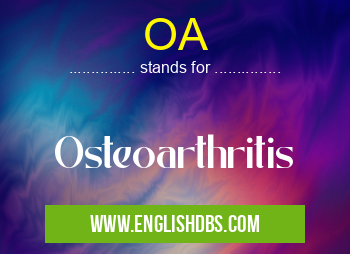What does OA mean in SURGICAL
Osteoarthritis, commonly abbreviated as OA, is a painful and progressive form of arthritis commonly affecting the joints in the hands, feet and spine. This type of arthritis is typically caused by age-related wear and tear and can cause severe pain, inflammation, stiffness and swelling. Osteoarthritis is one of the most common forms of arthritis worldwide, with an estimated 10 million Americans suffering from it. While there are no known cures for Osteoarthritis, there are treatments such as physical therapy, medications and lifestyle changes that may help to reduce symptoms and improve overall quality of life.

OA meaning in Surgical in Medical
OA mostly used in an acronym Surgical in Category Medical that means Osteoarthritis
Shorthand: OA,
Full Form: Osteoarthritis
For more information of "Osteoarthritis", see the section below.
Definition
The abbreviation “OA†stands for "Osteoarthritis", a degenerative medical condition that affects joints due to aging or excessive use. Osteoarthritis results in damage to the cartilage that cushions the bones in the affected joint which causes pain and restricts movement. People suffering from this condition will often experience symptoms such as persistent pain, stiffness in their joints, swelling and heat in their joints. As well as decreased range of motion or difficulty when doing daily activities such as walking or writing with a pen.
Essential Questions and Answers on Osteoarthritis in "MEDICAL»SURGICAL"
What is Osteoarthritis?
Osteoarthritis is a type of joint disease caused by inflammation, breakdown, and eventual loss of cartilage in the joints. It usually affects middle-aged and older adults. Symptoms vary from person to person but can include pain, tenderness, stiffness, joint swelling, and cracking or grating sounds when moving the affected joints.
What are some potential risk factors for Osteoarthritis?
There are several potential risk factors for developing osteoarthritis, including age, obesity, family history of the condition, prior joint injury/trauma/surgery and certain occupations that place excessive strain on the joints.
What kind of treatments are available to manage Osteoarthritis?
Depending on the severity of the condition, a variety of treatments may be used to manage symptoms associated with osteoarthritis. These may include lifestyle changes such as healthy eating habits and weight management; physical therapy; medications; injections; and surgical options such as joint replacement.
Is there any way to prevent Osteoarthritis?
While we cannot prevent all cases of osteoarthritis due to genetic or other factors out of our control, there are ways to minimize your risk by maintaining a healthy weight through diet and exercise and avoiding high-impact activities or sports which can put stress on joints. Additionally, taking measures to protect your joints at work (e.g., using tools that help reduce strain) is a preventive step you can take if applicable.
Does my diet have an impact on my chances of getting Osteoarthritis?
Yes! Following a healthy diet full of anti-inflammatory foods has been shown to reduce risks associated with osteoarthritis such as pain and stiffness. Healthy dietary choices include omega-3 fatty acids found in fish such as salmon or tuna; dark green leafy vegetables like spinach or kale; fruits rich in antioxidants like blueberries or pomegranate; lean proteins like tofu or beans; whole grains such as quinoa or oats; nuts like almonds or walnuts; herbs & spices like ginger or turmeric.
Are there any lifestyle changes that may help with managing Osteoarthritis symptoms?
Yes - making some lifestyle modifications can go a long way in helping you manage your symptoms. Regular exercise is essential for maintaining healthy Joints since it increases strength around them while also improves flexibility. Participating in low-impact activities such as walking or swimming can be beneficial for those with mild forms of arthritis along with practicing relaxation techniques (such as yoga) for managing stress levels
Final Words:
While there is currently no cure for osteoarthritis (OA), there are various treatments available to reduce symptoms such as medications, physical therapy exercises and lifestyle changes like diet modifications or weight loss that can help improve overall quality of life for those living with this chronic condition. Being educated on proper management techniques is essential to keep OA under control so it's important to talk to your doctor if you think you may have this type of arthritis.
OA also stands for: |
|
| All stands for OA |
